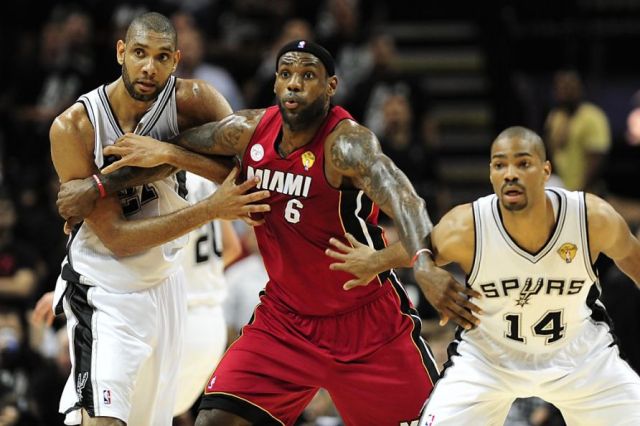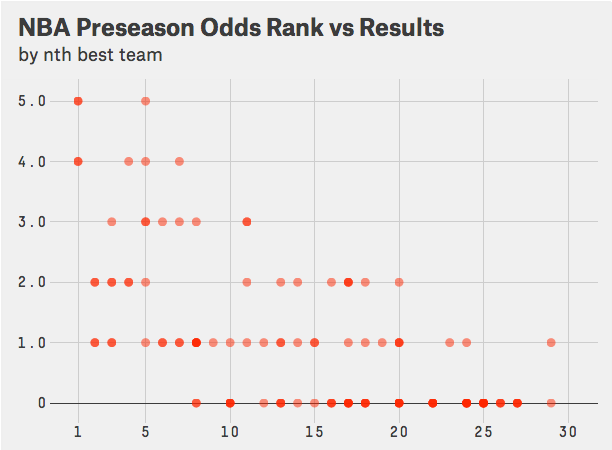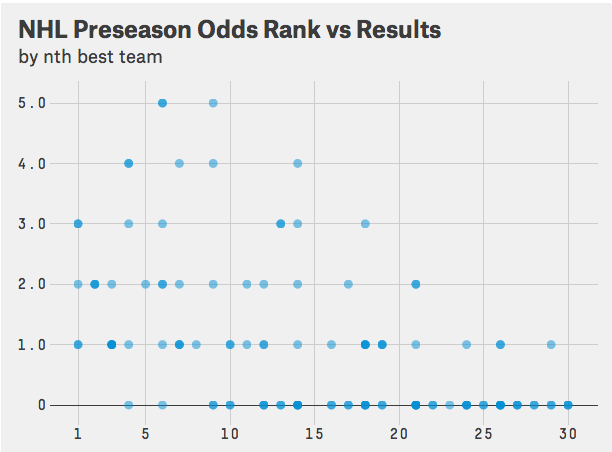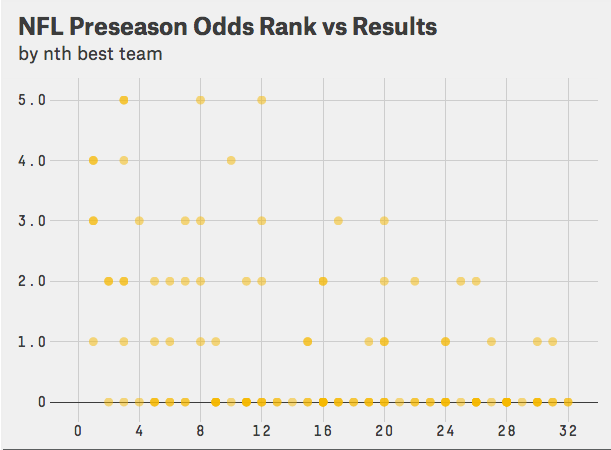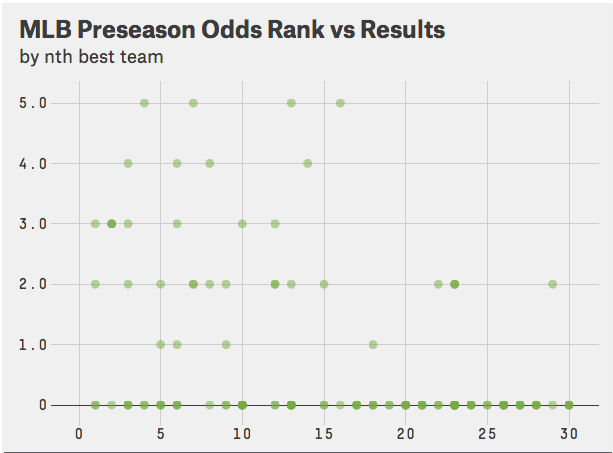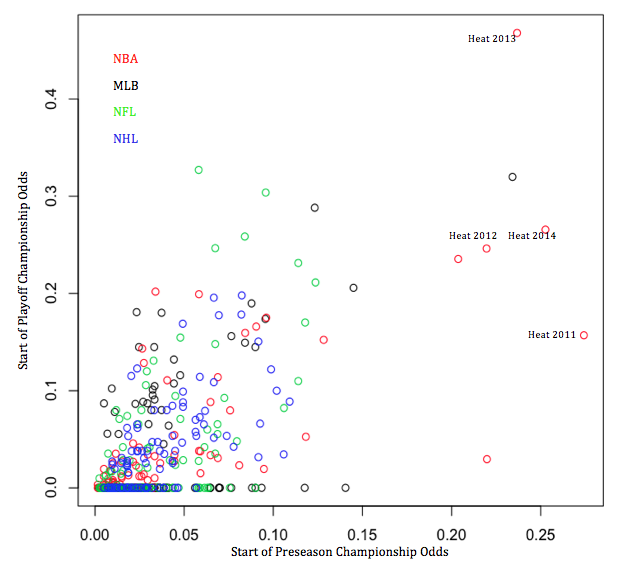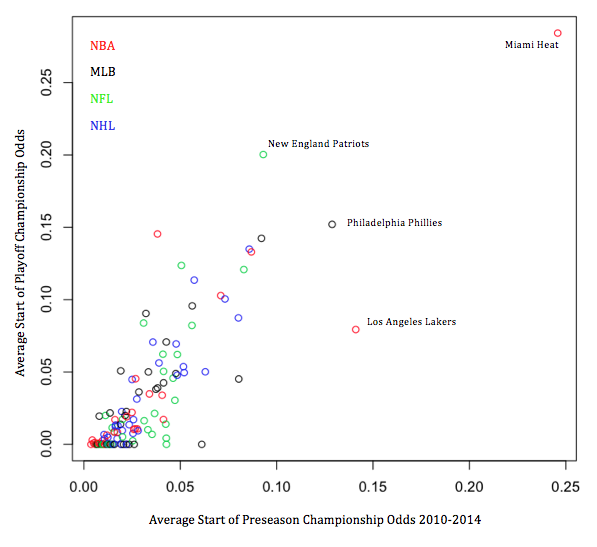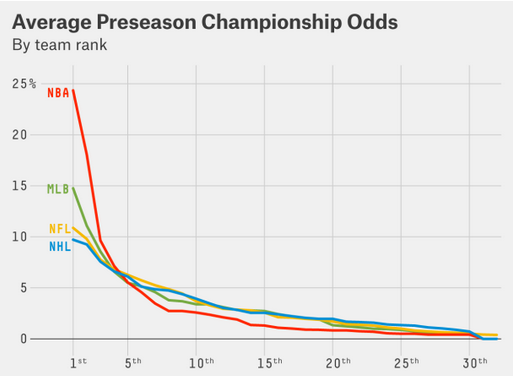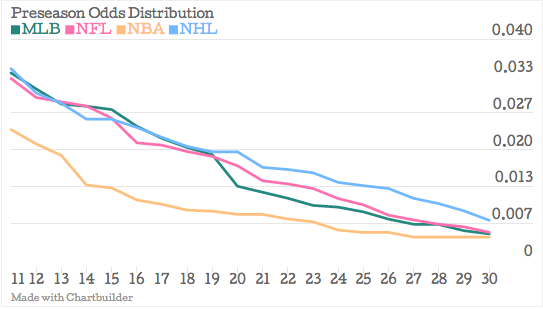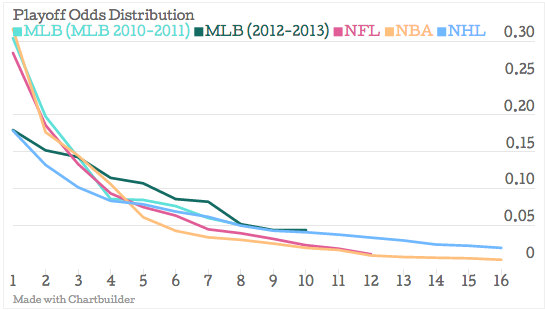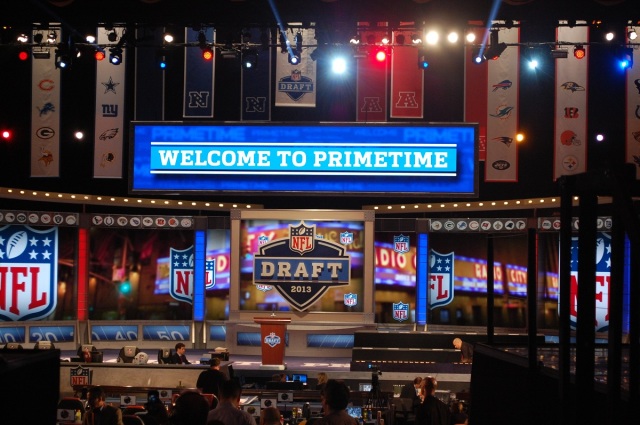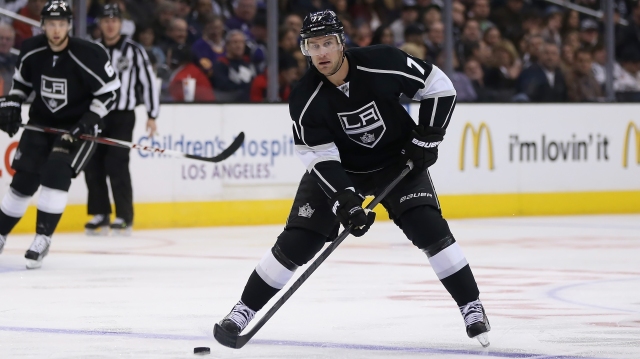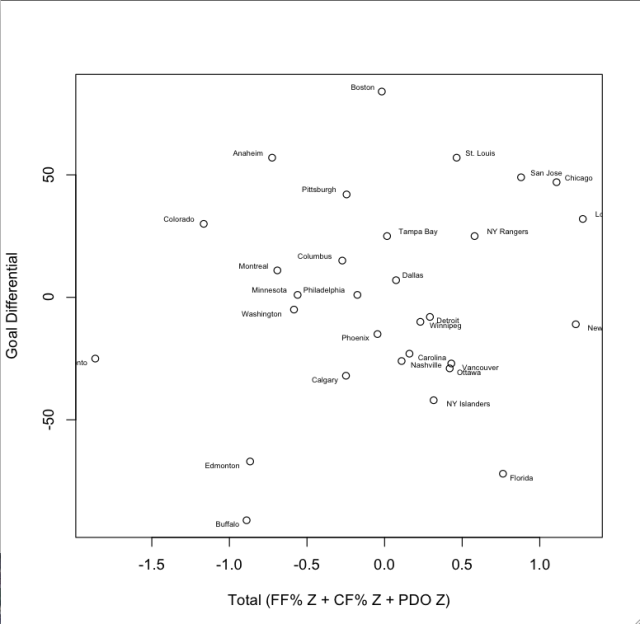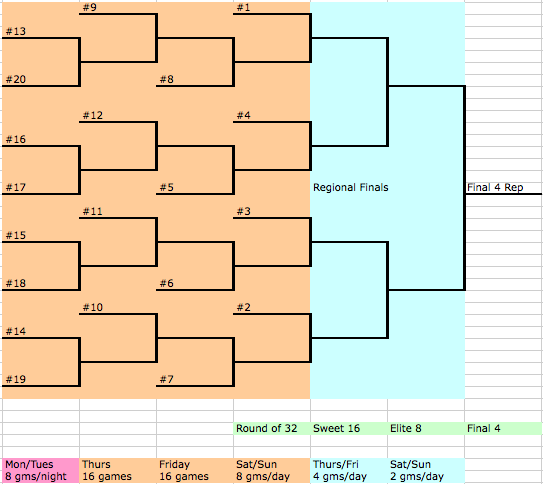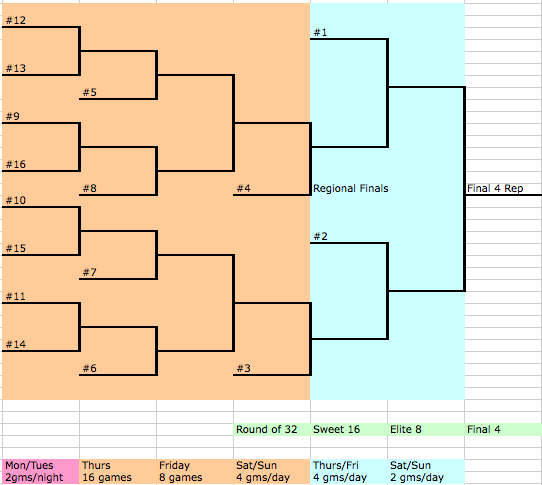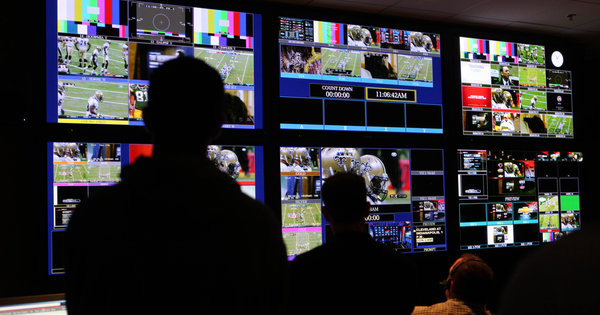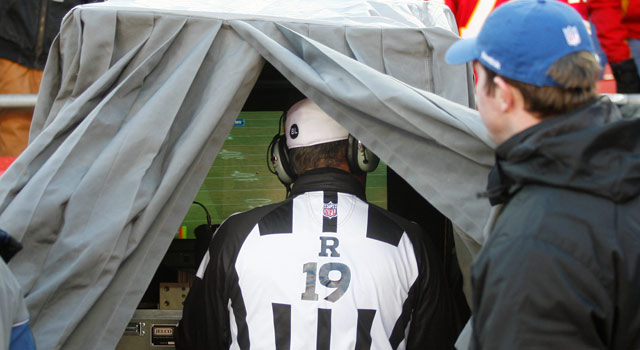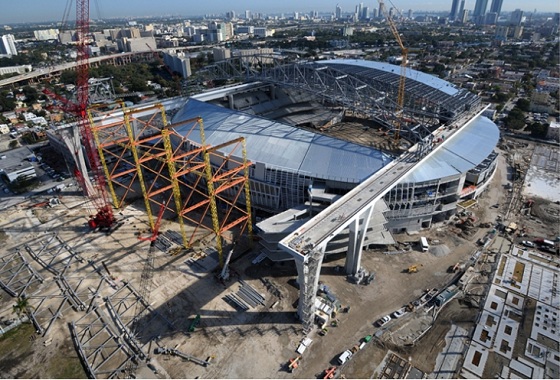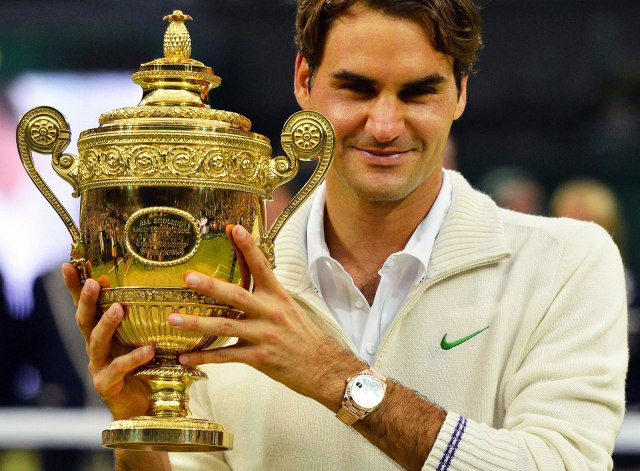While the NBA has successfully suckered tens of millions of fans into believing the 2014 playoffs have been thrilling and unpredictable, with the LA Times even declaring, “March Madness suddenly seems like such a bore by comparison” (this is a pretty odd comparison considering the Final Four concluded with a No. 7 seed beating a No. 8 for the title), I’ve had a much different opinion, and this year’s predictable results simply fall in line with recent history.
While my original post mostly analyzed the odds distribution in each sport, I didn’t much consider the actual results, and it got me wondering… How well do those futures odds predict what actually happens on the court, as well as in other sports?
To analyze this, I ranked all the teams in each sport according to their preseason championship odds* (i.e. for 2014, Miami is No. 1, Bulls No. 2, etc.) I then plotted this rank against their eventual playoff results (0 = missed playoffs, 1 = lost in first round, 2 = made conference semifinals, 3 = made conference finals, 4 = made finals, 5 = won title) over the last four seasons. For comparison, I also included the NHL, a league that also has an 82-game regular season and four rounds of best-of-seven playoffs:
*Because any betting odds will add up to greater than 100 percent, I simply divided all the futures by the sum of all the teams’ odds to scale them down to 100 percent.
The NBA has a clear strong correlation between preseason championship probability rank and playoff results, while the NHL is much weaker. Over the last four years, no NBA team ranked lower than fifth in preseason championship odds has made the finals. Compare that to the NHL, which has had six of eight non-top five finals teams in that time.
Here are the NFL and MLB distributions too:
(0 = missed playoffs, 1 = lost in wild card round, 2 = lost in divisional round, 3 = lost in conference championship game, 4 = lost Super Bowl, 5 = won Super Bowl)
(0 = missed playoffs, 1 = lost in Wild Card game, 2 = lost in LDS, 3 = lost in LCS, 4 = lost World Series, 5 = won World Series)
It’s easy to see how these other leagues’ plots differ from the NBA’s. Here are the correlations for each graph:
NBA = .647
NHL = .523
NFL = .440
MLB = .371
Clearly, the preseason favorites go further in the playoffs with a much higher frequency in the NBA than in any other sport.
Dominance of Miami
Much of the predictability in the NBA is due to the havoc the Miami Heat have waged on the wagering markets. To put Miami’s sports book dominance during the LeBron-Wade-Bosh era in perspective, here’s a scatter plot of the all the seasons in the MLB, NHL, NBA, and NFL over the last four seasons, plotting each team’s championship odds at the start of the season against their odds at the start of the playoffs.
(Sorry, no pretty graphic with this one—just a screenshot of an R plot. Chartbuilder doesn’t take to kindly to doing scatter plots with multiple series.)
Only once in the last four years have the Heat not been favorites to win the title—the start of the 2011 playoffs, following the Big Three’s underwhelming debut regular season. Now, to really see how Miami’s recent run stands out, here are those odds when the four years for each team are averaged together.
Over the last four seasons, the Heat have averaged 24.6 percent and 28.4 percent chances of winning the title at the start of the regular season and postseason respectively. Compare that to the Sacramento Kings, which have averaged 0.3 percent and 0.0 percent respectively over that time.
Another interesting takeaway from this chart is that the Patriots have often wildly outperformed preseason expectations during the regular season, accruing more than double the title odds by the time the playoffs start. The Lakers, on the other hand, wildly underperform (or are simply very overvalued at the start of the year), nearly slicing their preseason title odds in half over the course of the regular season.
Odds Distributions
Probably the most striking image from my FiveThirtyEight story was this line chart of the distribution of championship odds at the start of the season in each sport.
When you zoom in on the bottom two thirds of the chart, you can really see the near-zero odds of the barren bottom 50 percent in the NBA.
This NBA inequality is still apparent come playoff time. (I separated the MLB data into the years in which there was only one wild card per league and years in which there were two.)
While the NBA may look like it’s made up some ground here equality-wise, it’s important to note that the NFL and MLB have byes and play-in games, a structural advantage that automatically adds greater disparity in championship odds. The average top NBA playoff team, which has to win four rounds for the championship, still has better title odds than the average top MLB and NFL teams, which only have to win three rounds.
Solutions
The day after my FiveThirtyEight story ran, the NY Times published a story that touched on very similar topics. Most interestingly came a quote from former Stanford professor Roger Noll, discussing one of my most despised regulations in sports:
“If you didn’t have an individual cap,” Noll said in a telephone interview, “if LeBron James was in a position to sell himself to the highest bidder, his salary would be much higher and you wouldn’t have a small number of top teams with more than half the superstars in the league.”
“It’s a big mistake, and the N.B.A. hasn’t adjusted. So if you have as many as 25 teams that know before the first game is played that they probably won’t even be in the conference finals, doesn’t that make the regular season seem almost meaningless, more of an exhibition than a pathway to a consequential championship?”
I couldn’t agree more (and plan to write more on this in the NBA off-season).
In previous posts, I’ve argued against the randomness and extreme parity of college basketball, much of which is due to the 68-team single elimination playoff format—a huge contrast to the NBA’s best-of-seven series. If that sounds like the complete opposite of my above criticism of the NBA, then you’re right. The NCAA lies too far toward the extreme randomness/parity end of the spectrum, while the NBA goes too far to the extreme predictability/inequality end.
You don’t want seasons to feel like they’re extremely predictable like the NBA, but at the same time, you want the true best team to win with a relatively high frequency so that it feels like teams are justly rewarded. It’s critical to have a good balance between the two, and finding that equilibrium is something sports leagues have wrestled with—and will continue to wrestle with—for decades.
